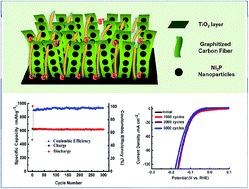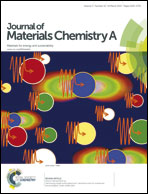Novel peapod array of Ni2P@graphitized carbon fiber composites growing on Ti substrate: a superior material for Li-ion batteries and the hydrogen evolution reaction†
Abstract
A novel one-dimensional (1-D) peapod array of nickel phosphide (Ni2P)@graphitized carbon fiber composites consisting of graphitized carbon fiber and the encapsulated Ni2P nanoparticles has been designed and synthesized on titanium foil substrate. This smart and elaborate architecture design offers several remarkable advantages, including large interfacial area, short charge transporting path, strong physical adhesion with the current collector and large electrolyte diffusion pathway between the peapod array. When used for lithium ion batteries, excellent electrochemical performances such as a high capacity of 634 mA h g−1 at a current density of 200 mA g−1, long-term cycling stability and outstanding rate capability, are obtained. In 0.5 M sulfuric acid, as an electrocatalyst for hydrogen evolution reaction, the peapod array of Ni2P@graphitized carbon fiber composites gives a current density of 10 mA cm−2 at a small over-potential of 45 mV and a small Tafel slope of ∼46 mV decade−1. More importantly, the sample exhibits exceptional stability in an acidic environment. Furthermore, it is believed that the idea to prepare the 1-D peapod array on a conductive substrate is generic and could be extended to be used with other materials.


 Please wait while we load your content...
Please wait while we load your content...